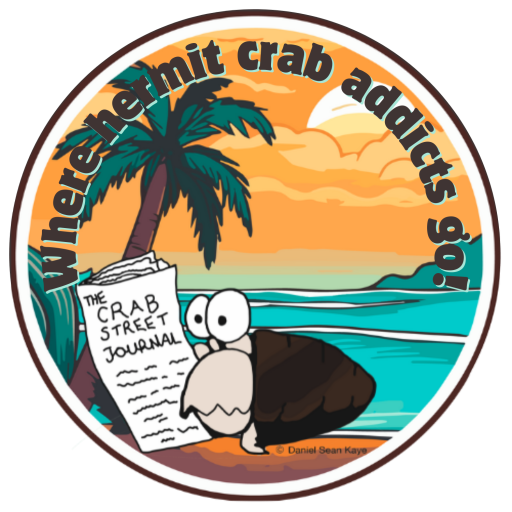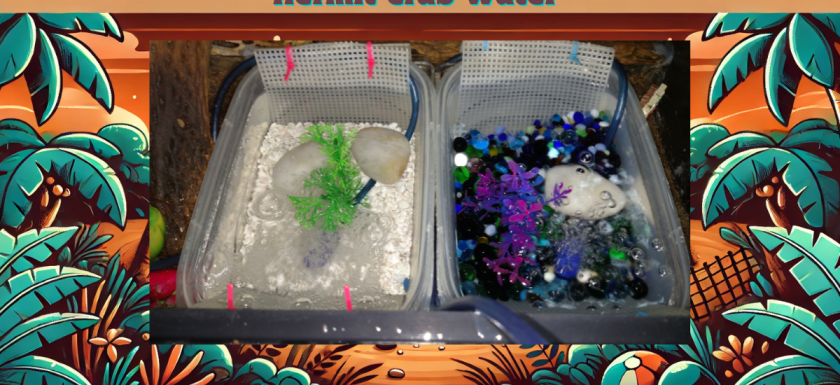Originally written by Vanessa Pike-Russell-Updated by Stacy Griffith
All hermit crabs require some access to salt in their diet, no matter what species. The habitat of land hermit crab species differs from location to location, and they have adapted to the environment they live in.
Approximately 3.5%, or 35 parts per thousand solution is recommended for the “Ocean Water” pool within your tank. Typically mixing according to package directions is sufficient. If you are using distilled or spring water it may have varying amounts of salt already within the water, so take that into consideration.. It is important to note which type of water you use.
Varying habitats of land hermit crab species.
It may surprise you to know that the habitat of land hermit crabs is rather diverse. Some live in rainforest areas while others exist on coral atolls or inland areas. If you have many species within the same crabitat then you will notice that some will drink more sea or ocean water than others. It is important that you provide an ocean or sea salt water pond within your crabitat so that each crab can take what it needs and lead a happy and healthy life.
“Although there are relatively few species of Coenobita, individuals are numerous in tropical and subtropical maritime regions particularly supralittoral areas and small islands, although some penetrate further inland. Certain species are restricted to beaches (e.g. C. perlatus (H. Milne Edwards, 1837), C. scaevola (Forskal 1775), C. spinosus (H. Milne Edwards, 1837), C. cavipes (Stimpson, 1838) while several other species may penetrate long distances inland, e.g. C. clypeatus (Herbst, 1791) on Curacao, C. rubescens (Greeff) and C. brevimanus (Dana, 1852) in rainforest, C. compressus (H. Milne Edwards) (de Wilde; 1973; Burggren and McMahon, 1988). Coenobita rugosus (H. Milne Edwards, 1837) may live on the beach or penetrate inland in situations where fresh water is available (Yamaguchi, 1938; Vannini, 1976). stages.” Greenaway (2003 p. 13)
Beach-dwelling Land Hermit Crabs Some hermit crabs live on or close to beaches and would have access to seawater and a diet high in salt. In captivity they will need access to sea water. You will often find hermit crabs which have been denied sea salt water solutions spending a lot of time in the ocean water dish once you get them home.
“Certain species are restricted to beaches (e.g. C. perlatus (H. Milne Edwards, 1837), C. scaevola (Forskal 1775), C. spinosus (H. Milne Edwards, 1837), C. cavipes (Stimpson, 1838)… Beach-dwelling coenobitids drink seawater or extract it from damp sand and often immerse themselves to flush the shell.. ” Greenaway (2003 p. 13-16
Other land hermit crabs, despite living away from beach areas, will drink the sea water from time to time or access salt through their diet. You may find your Caribbean (Purple Pincer aka C. clypeatus) hermit crabs drinking the sea water. While they may not have ready access to seawater in the wild they do drink it while in captivity, and there is often a link between excessive drinking of sea water and an impending moult.
“Coenobita spp. that live away from the beach do not usually have access to seawater and indeed these species prefer dilute water unless they are depleted of salt (de Wilde, 1973). ” Greenaway (2003 p. 16)
How to create ‘Ocean Water’ from Synthetic Sea Salt
If the package doesn’t give mixing directions you will be safe using this ratio: Mix eight tablespoons (1/2 cup) of Marine Salt to a Gallon (4 Litres) of dechlorinated water. This equates to roughly 2 tablespoon per Quart/Litre.
Once mixed, the solutions should be permitted to sit for 12-24 hours prior to serving to ensure the ocean crystals have dissolved. Make sure that you shake the solution if it has been left to stand thus to dissolve any undissolved salt crystals.
Quality brands which may be used include Instant Ocean, Instant Ocean Reef Crystals, CoralSea, Oceanic, Reef Crystals from Aquarium Systems, and Tropic Marin. Each brand should be mixed according to the instructions on the package.
For further information, and smaller quantity mixing directions, please see the FAQ How Do I Mix Ocean Water for Hermit Crabs page.
Instant Ocean
From the Aquarium Systems website:
“Instant Ocean synthetic sea salt contains every necessary major, minor, and trace element and has no nitrates and no phosphates. It was developed through sophisticated biological and chemical testing, and every batch is analyzed to assure consistent high quality. Exceptional solubility, uniform particle size, and outstanding package value have made Instant Ocean salt the choice of aquarists for over 30 years. No other product outperforms Instant Ocean salt. Our guarantee of quality is supported by a history of proven usage. Instant Ocean is the world’s most popular brand of synthetic sea salt.”
Tropic Marin
From the Tropic Marin website:
“Tropic Marin sea salt is manufactured from pharmaceutically pure salts and is based upon the most recent scientific analysis of the tropical oceans. It is free from synthetic additives and contains no nitrates, phosphates or silicates. Tropic Marin Sea Salt turns fresh water into salt water, which is practically indistinguishable from natural seawater.”
References:
- Greenaway, P. (2003)Terrestrial adaptations in the Anomura (Crustacea: Decapoda). Memoirs of Museum Victoria 60(1): 13-26 (2003).
- Aquarium Systems:: Salts
- Tropic Marin

